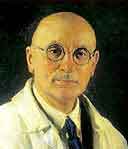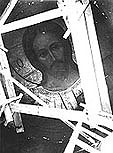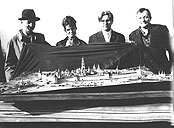G.A. MÀKÀRÎVSÊÀYA
“On the Problem of Restoration of the Architectural Ensemble
of the Trinity-St. Sergius Lavra between the 1920s and1990s
(page 5)
 The permanent restoration commission of the Scientific Council included famous architects, historians, archeologists, engineers, art historians: Academicians I.V. Rylsky, N.V. Zholtovsky, I.E. Grabar, S.V. Bakhrushin; Professors A.V.Artsikhovsky, P.V.Shchusev, V.N.Kononov, V.I. Lebedev, N.N.Sobolev, V.P.Zubov. There were constantly involved engineers - S.N. Bobin, B.A. Smolyak, N.A. Brukhansky, I.G. Senatov; professors - D.I. Kiplik, G.A. Novitsky, A.G. Gabrichevsky; general-lieutenant D.M. Karbyshev- an expert in applied art; professor F.Ya. Mishukov. They obviously lacked specialists in restoration. In 1939-1941, 22 probationer students from the Russian Academy of Arts and from the Moscow Architectural Institute took part in the restoration directed by I.V. Trofimov.
The permanent restoration commission of the Scientific Council included famous architects, historians, archeologists, engineers, art historians: Academicians I.V. Rylsky, N.V. Zholtovsky, I.E. Grabar, S.V. Bakhrushin; Professors A.V.Artsikhovsky, P.V.Shchusev, V.N.Kononov, V.I. Lebedev, N.N.Sobolev, V.P.Zubov. There were constantly involved engineers - S.N. Bobin, B.A. Smolyak, N.A. Brukhansky, I.G. Senatov; professors - D.I. Kiplik, G.A. Novitsky, A.G. Gabrichevsky; general-lieutenant D.M. Karbyshev- an expert in applied art; professor F.Ya. Mishukov. They obviously lacked specialists in restoration. In 1939-1941, 22 probationer students from the Russian Academy of Arts and from the Moscow Architectural Institute took part in the restoration directed by I.V. Trofimov.
 The situation with specialists was most complicated during the war and in the post-war period. In 1945, they opened the art and industry vocational school with a 3- year training program where they prepared restorers of six specialties: white-stone masons, brick-layers, white-stone molders, carpenters, cabinet-makers and restorers of icons and frescoes.
The situation with specialists was most complicated during the war and in the post-war period. In 1945, they opened the art and industry vocational school with a 3- year training program where they prepared restorers of six specialties: white-stone masons, brick-layers, white-stone molders, carpenters, cabinet-makers and restorers of icons and frescoes.
 V.I. Baldin was the director of the vocational school between 1945 and 1950. The presence of experts allowed to develop large-scale works. The restoration of the architectural ensemble of the Trinity-St. Sergius Lavra, carried out between 1938 and 1950 brought significant results. It determined the direction and scale of works for many subsequent years. In 1950 – 1963, the
research and restoration of the monuments of the Trinity-St. Sergius Lavra were carried out by the Central Scientific Restoration Workshops of the USSR Academy of Architecture. Architects V.I.Baldins and À.G. Ustinov worked out the complex project of restoration (1963).
V.I. Baldin was the director of the vocational school between 1945 and 1950. The presence of experts allowed to develop large-scale works. The restoration of the architectural ensemble of the Trinity-St. Sergius Lavra, carried out between 1938 and 1950 brought significant results. It determined the direction and scale of works for many subsequent years. In 1950 – 1963, the
research and restoration of the monuments of the Trinity-St. Sergius Lavra were carried out by the Central Scientific Restoration Workshops of the USSR Academy of Architecture. Architects V.I.Baldins and À.G. Ustinov worked out the complex project of restoration (1963).
 The project had been preceded by the investigation of the inventory and archive materials, measurements, destruction of the later elements. They revealed the original appearance and subsequent changes, and allowed to trace the steps in the development of the ensemble. The project suggested that the ensemble should be cleared of all casual changes. It emphasized its compositional peculiarities. The restoration of each monument did not necessarily mean returning to its initial appearance. It considered the position of the monument in the ensemble in connection with other buildings. The analysis of the stage-by-stage development of the ensemble made by V.I. Baldin gave a comprehensive idea of its space arrangement, silhouette, color scheme and compositional integrity with city.
The project had been preceded by the investigation of the inventory and archive materials, measurements, destruction of the later elements. They revealed the original appearance and subsequent changes, and allowed to trace the steps in the development of the ensemble. The project suggested that the ensemble should be cleared of all casual changes. It emphasized its compositional peculiarities. The restoration of each monument did not necessarily mean returning to its initial appearance. It considered the position of the monument in the ensemble in connection with other buildings. The analysis of the stage-by-stage development of the ensemble made by V.I. Baldin gave a comprehensive idea of its space arrangement, silhouette, color scheme and compositional integrity with city.
|


